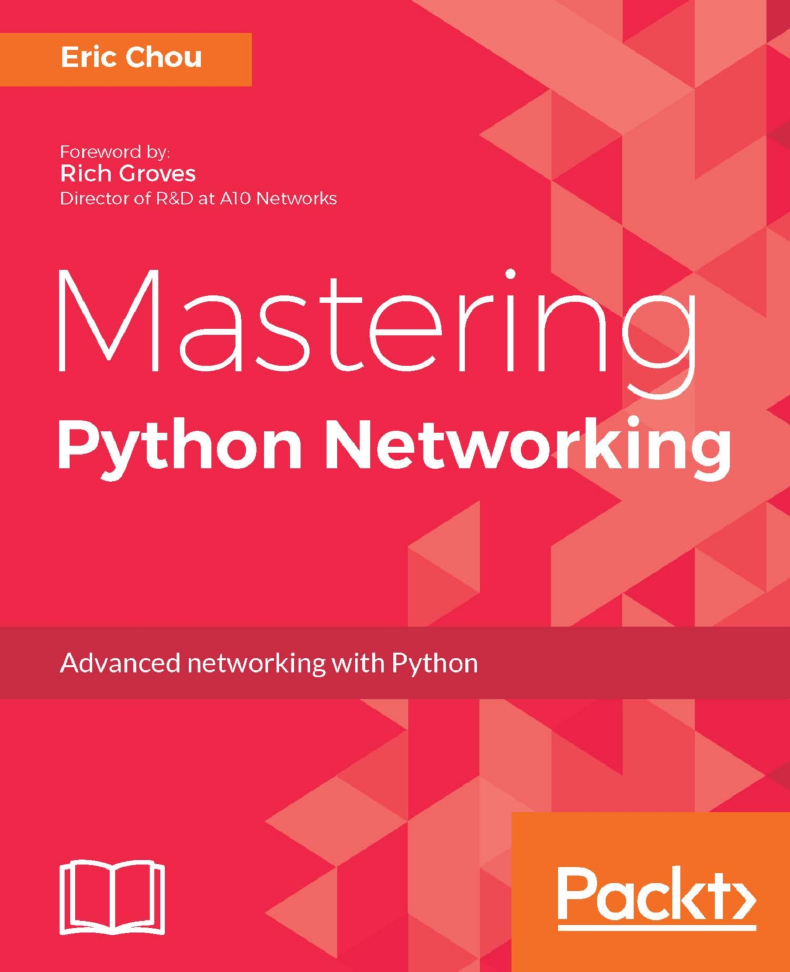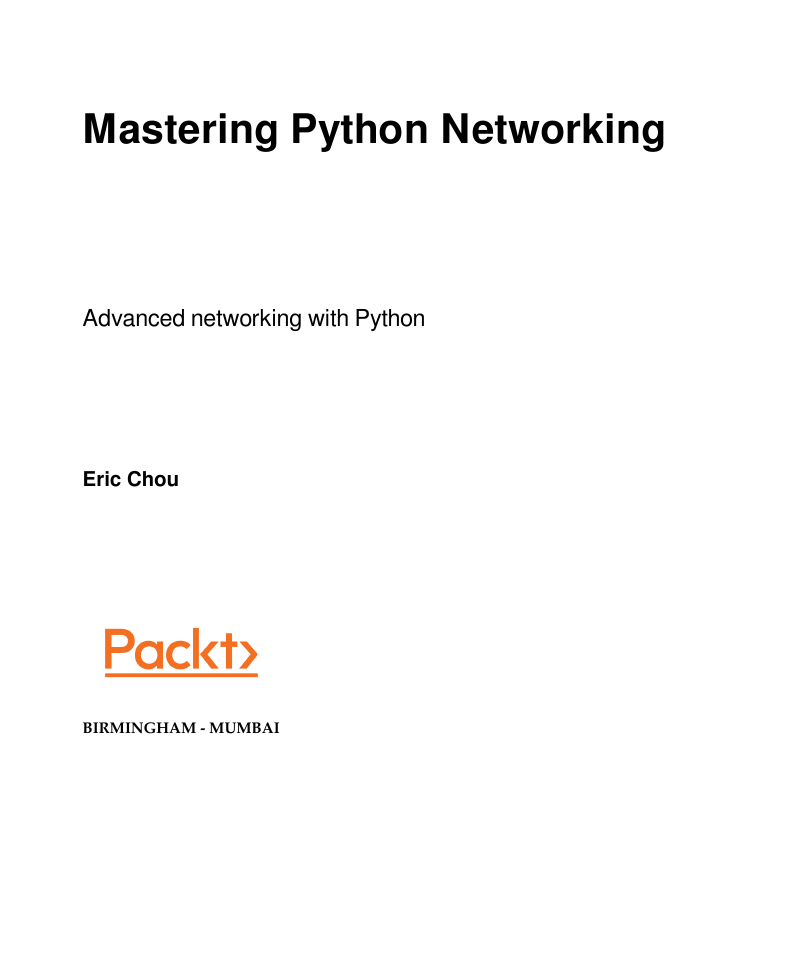Cover
Copyright
Foreword
About the Author
Table of Contents
Preface
1: Review of TCP/IP Protocol Suite and Python Language
The internet overview
Servers, hosts, and network components
The rise of datacenter
Enterprise datacenters
Cloud datacenters
Edge datacenters
The OSI model
Client server models
Network protocol suites
The Transmission Control Protocol (TCP)
Functions and Characteristics of TCP
TCP messages and data transfer
User Datagram Protocol (UDP)
The Internet Protocol (IP)
The IP NAT and security
IP routing concepts
Python language overview
Python versions
Operating system
Running a Python program
Python built-In types
The None type
Numerics
Sequences
Mapping
Sets
Python operators
Python control flow tools
Python functions
Python classes
Python modules and packages
Summary
2: Low-Level Network Device Interactions
The challenges of CLI
Constructing a virtual lab
Cisco Virtual Internet Routing Lab (VIRL)
VIRL tips
Cisco DevNet and dCloud
GNS3
Python Pexpect Library
Installation
The Pexpect overview
Our first Expect program
More Pexpect features
Pexpect and SSH
Putting things together for Pexpect
The Python Paramiko library
Installating Paramiko
The Paramiko overview
Our first Paramiko program
More Paramiko features
Paramiko for Servers
Putting things together for Paramiko
Looking ahead
Downsides of Pexpect and Paramiko compared to other tools
Idempotent network device interaction
Bad automation speeds bad things up
Summary
3: API and Intent-Driven Networking
Infrastructure as the Python code
Screen scraping versus API structured output
Data modeling for infrastructure as code
The Cisco API and ACI
Cisco NX-API
Lab Software Installation and Device Preparation
NX-API examples
Cisco and YANG model
The Cisco ACI
The Python API for Juniper networks
Juniper and NETCONF
Device Preparation
Juniper NETCONF examples
Juniper PyEZ for developers
Installation and preparation
PyEZ examples
The Arista Python API
The Arista eAPI management
The eAPI preparation
eAPI examples
The Arista Pyeapi library
The Pyeapi installation
Pyeapi examples
Vendor neutral libraries
Summary
4: The Python Automation Framework - Ansible Basics
A quick Ansible example
The control node installation
Your first Ansible playbook
The Public key authorization
The inventory file
Our first playbook
The advantages of Ansible
Agentless
Idempotent
Simple and extensible
The vendor Support
The Ansible architecture
YAML
Inventories
Variables
Templates with Jinja2
Ansible networking modules
Local connections and facts
Provider arguments
The Ansible Cisco example
The Ansible Juniper example
The Ansible Arista example
Summary
5: The Python Automation Framework - Ansible Advance Topics
Ansible conditionals
The when clause
Network module conditional
Ansible loops
Standard loops
Looping over dictionaries
Templates
The Jinja2 template
Jinja2 loops
The Jinja2 conditional
Group and host variables
Group variables
Host variables
The Ansible vault
The Ansible include and roles
The Ansible include statement
Ansible roles
Writing your own custom module
The first custom module
The second custom module
Summary
6: Network Security with Python
The lab setup
Python Scapy
Installing Scapy
Interactive examples
Sniffing
The TCP port scan
The ping collection
Common attacks
Scapy resources
Access lists
Implementing access lists with Ansible
MAC access lists
The syslog search
Searching with regular expressions
Other tools
Private VLANs
UFW with Python
Summary
7: Network Monitoring with Python - Part 1
Lab setup
SNMP
Setup
PySNMP
Python visualization
Matplotlib
Installation
Matplotlib - the first example
Matplotlib for SNMP results
Additional Matplotlib resources
Pygal
Installation
Pygal - the first example
Pygal for SNMP results
Additional Pygal resources
Python for Cacti
Installation
Python script as an input source
Summary
8: Network Monitoring with Python - Part 2
Graphviz
Lab setup
Installation
Graphviz examples
Python with Graphviz examples
LLDP neighbor graphing
Information retrieval
Python parser script
Final playbook
Flow-based monitoring
NetFlow parsing with Python
Python socket and struct
ntop traffic monitoring
Python extension for ntop
sFlow
SFlowtool and sFlow-RT with Python
Elasticsearch (ELK stack)
Setting up a hosted ELK service
The logstash format
Python helper script for Logstash formatting
Summary
9: Building Network Web Services with Python
Comparing Python web frameworks
Flask and lab setup
Introduction to Flask
The HTTPie client
URL routing
URL variables
URL generation
The jsonify return
Network static content API
Flask-SQLAlchemy
Network content API
Devices API
The device ID API
Network dynamic operations
Asynchronous operations
Security
Additional resources
Summary
10: OpenFlow Basics
Lab setup
Introducing OpenFlow
Basic operations
OpenFlow 1.0 vs 1.3
Mininet
The Ryu controller with Python
Open vSwitch commands
The Ryu firewall application
Layer 2 OpenFlow switch
Planning your application
Application components
The POX controller
Summary
11: Advanced OpenFlow Topics
Setup
OpenFlow operations with Ryu
Packet inspection
Static router
Mininet topology
Ryu controller code
Ryu flow installation
Ryu packet generation
Final result
Router with API
Ryu controller with API
API usage examples
BGP router with OpenFlow
Lab router setup
Python with the BGP speaker library
Ryu BGP application
Firewall with OpenFlow
Summary
12: OpenStack, OpenDaylight, and NFV
OpenStack
OpenStack overview
Networking in OpenStack
Trying out OpenStack
OpenDaylight
OpenDaylight programming overview
OpenDaylight example
Summary
13: Hybrid SDN
Preparing the network
Familiarize yourself with the existing framework and tools
Network standardization
Create minimum viable products
Relentlessly experiment
Greenfield deployment
Controller redundancy
Multiple controller example
BGP migration example
Migration segmentation
VIRL and Mininet setup
Cisco device configuration
Ryu BGP speaker
Mininet and REST Router
Result and verification
More BGP example
Examine the JSONRPC over WebSocket
Monitoring integration
Secure TLS connection
Physical switch selection
Lab OpenFlow switches
Incumbent vendor switches
Whitebox Switches
Summary
Index
















 2023年江西萍乡中考道德与法治真题及答案.doc
2023年江西萍乡中考道德与法治真题及答案.doc 2012年重庆南川中考生物真题及答案.doc
2012年重庆南川中考生物真题及答案.doc 2013年江西师范大学地理学综合及文艺理论基础考研真题.doc
2013年江西师范大学地理学综合及文艺理论基础考研真题.doc 2020年四川甘孜小升初语文真题及答案I卷.doc
2020年四川甘孜小升初语文真题及答案I卷.doc 2020年注册岩土工程师专业基础考试真题及答案.doc
2020年注册岩土工程师专业基础考试真题及答案.doc 2023-2024学年福建省厦门市九年级上学期数学月考试题及答案.doc
2023-2024学年福建省厦门市九年级上学期数学月考试题及答案.doc 2021-2022学年辽宁省沈阳市大东区九年级上学期语文期末试题及答案.doc
2021-2022学年辽宁省沈阳市大东区九年级上学期语文期末试题及答案.doc 2022-2023学年北京东城区初三第一学期物理期末试卷及答案.doc
2022-2023学年北京东城区初三第一学期物理期末试卷及答案.doc 2018上半年江西教师资格初中地理学科知识与教学能力真题及答案.doc
2018上半年江西教师资格初中地理学科知识与教学能力真题及答案.doc 2012年河北国家公务员申论考试真题及答案-省级.doc
2012年河北国家公务员申论考试真题及答案-省级.doc 2020-2021学年江苏省扬州市江都区邵樊片九年级上学期数学第一次质量检测试题及答案.doc
2020-2021学年江苏省扬州市江都区邵樊片九年级上学期数学第一次质量检测试题及答案.doc 2022下半年黑龙江教师资格证中学综合素质真题及答案.doc
2022下半年黑龙江教师资格证中学综合素质真题及答案.doc